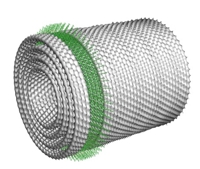
Max-Planck-Institut für Bioanorganische Chemie, Mülheim a.d. Ruhr, Germany
e-mail: holzwarth@mpi-muelheim.mpg.de
URL: http://www.mpibac.mpg.de/bac/mitarbeiter/holzwarth/holzwarth_en.php

 |
Alfred R. Holzwarth
Max-Planck-Institut für Bioanorganische Chemie, Mülheim a.d. Ruhr, Germany e-mail: holzwarth@mpi-muelheim.mpg.de URL: http://www.mpibac.mpg.de/bac/mitarbeiter/holzwarth/holzwarth_en.php |
 |
Green photosynthetic bacteria contain an organelle with extremely high light-capturing efficiency. These so-called chlorosomes contain bacteriochlorophylls (e.g. BChl c) that form supramolecular self-assembled light-harvesting systems containing several 100.000 BChl molecules without proteins and thus represent highly unusual natural antenna structures. The long-range structures of these systems are concentric nanotubes with diameters of 5-10 nm and lengths of up to several hundred nm.[1] Based on the organization principles of these natural systems we have developed artificial self-organized light-harvesting systems and photosynthetic units employing synthetically modified metallo-chlorins that are doped with small amounts of either energy trap molecules or electron transfer dyads.[2,3]
The optical properties of these supramolecular dye aggregates are characterized by strong excitonic interactions. The unusually exciton large delocalization lengths allow extremely efficient energy transfer processes which make such units ideal for artificial light-harvesting.[3] The ultrafast energy transport and trapping have been studied both in isolated chlorosomes and in artificial self-assembled chlorin nanostructures by ultrafast spectroscopy and single molecule fluorescence.[4]